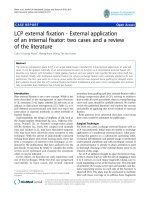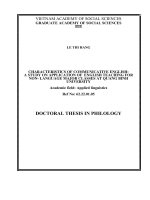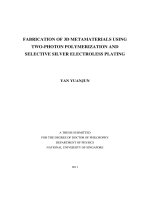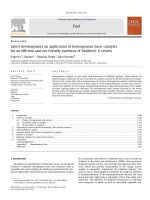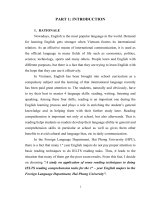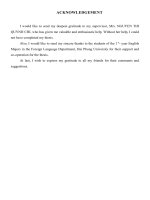project on Application of Disperse & Reactive Dyes In a P-C Blended Fabric of 65-35 In Using Two Bath System
Bạn đang xem bản rút gọn của tài liệu. Xem và tải ngay bản đầy đủ của tài liệu tại đây (400.67 KB, 30 trang )
PROJECT REPORT ON
Applicaon of Disperse & Reacve Dyes In a P/C Blended Fabric of 65/35 In Using Two
Bath System
BASIS OF
FAKIR APPARELS LTD.
BSCIC SHILPA NAGARY, FATULLAH, NARAYANGANJ
ACKNOWLEDGEMENT
Praise be to Allah the creator and sustainer who has given us strength and opportunity
to complete our two months long industrial attachment at “Fakir Apparels Ltd.”
Pabna Textile Engineering College has given me the opportunity to perform the
industrial project report with “Fakir Apparels Ltd.”. I am grateful to Md. Abdul
Mannan, the principal of the college for giving me the opportunity to accomplish the
attachment.
Special thanks go to my supervising teacher Shib Shankar Chakraborty Sir,
without whose help it would not have possible to complete the training successfully.
May I also take the opportunity to express my sincerest gratitude to “Fakir Apparels
Ltd.” management, and administration & personnel for their kind co-operation.
My deepest appreciation goes to ED-Sir and to DGM –Sir, who provided us all the
necessary information we needed.
Above all, I would like to acknowledge my deep debt to all teachers of our college and
especially of “WET PROCESSING TECHONOLOGY Department ”for their kind
inspiration and help, which remain as the backdrop of all my efforts.
Finally, I would like to acknowledge that I remain responsible for the inadequacies and
errors, which doubtless remain.
PROJECT TITLE
Applicaon of Disperse & Reacve Dyes In a P/C Blended Fabric
of 65/35 In Using Two Bath System.
Abstract
The dyeing of the polyester and co2on blend fabric (P/C fabric or PCF) has becomes a challenge to the
modern texle industries due to its variaon in color value, shed depth, tensile strength and surface
residual weight loss. All of this drawback can be control by the proper selecon of the dye-9ber
combinaon which ulmately governs the XRD, SEM, FTIR analysis of the dyed blend fabric. The water
fastness or wash fastness and light fastness can be also improved by the proper analysis of the
thermodynamic equilibrium of dye 9ber bond and its stoichiometry.
The present work deals with the ways of tesng the compability of disperse & reacve dyes with P/C
blended fabrics dyeing in di=erent texle industries in Bangladesh. This report includes three laboratory
trials that were carried out for three di=erent reacve dyes to check the compability for use in a dye
recipe on co2on kni2ed goods. In this study, Spectrophotometric analysis was conducted and the 9xaon
of each dye was determined by using computer colour matching system. The results found from di=erent
industries were analysed and discussed. This tesng can be used as a tool for selecng good quality dyes
as well as to reduce dyeing cost and hazard. Finally few recommendaons are highlighted to overcome
the problem of selecng be2er quality dyes for co2on goods in texle industries in Bangladesh.
Fiber reacve dyes for co2on were shown to vary widely in their substanvity for the 9ber. Substanvity
also depended on dye bath temperature and salt concentraon, as expected. The relave substanvies
of the hydrolyzed forms of the reacve dyes were assessed in the laboratory by means of a sample, quick
and inexpensive paper chromatography test. Correlaon of the substanvity of the dye with the amount
removed from the co2on under various washing condions indicated that it should be possible to select
higher or lower washing temperatures based on the substanvity of the dye to be removed. In addion,
the paper chromatography test was useful for quick selecon of dyes of about the same substanvity.
Mixtures of such dyes dyed co2on with li2le change in hue during the dyeing process; dyes of di=erent
substanvity gave pronounced color changes.
INTRODUCTION
If the theoretical knowledge is a glass of water, then the practical knowledge would be drinking of the water. So, for
any technical education the practical experience is the most important along with the theoretical knowledge.With
the evaluation of the wet processing industries the use of the reactive & disperse dyes in the most of the
industries increases day by day. As a result to complete the project it is has become a part to discus about the
evaluation or growth of the wet processing industries in Bangladesh. Now the number of the wet processing
industries and finishing industries in Bangladesh is 206 which are totally export oriented according to the survey
of the BTMA which has been provided into their web address.
The application & fixing of a dye to a substrate, normally with the intention of obtaining an even distribution
throughout the substrate. Dyeing is the Wet Processing Technology by which physical and chemical changes
happen in textile material.
Reactive dye stuffs directly combinds with cellulose by chemical bonding i.e. covalent bonds are produced. They
have excellent wash fastness. Mainly used on cotton dyeing. Can also be applied on wool, silk and nylon dyeing.
Dyeing is carried out in an alkaline bath.
By achieving Practical knowledge it is possible to apply the theoretical knowledge in the technical field. For any
technical education, practical experience is almost equally necessary in association with the theoretical
knowledge. The Industrial attachment is most effective process of achieving the practical experience. It provides
us sufficient practical knowledge about production, management, productivity, evaluation, work study, efficiency,
Industrial management, production planning & control, Production cost analysis, inventory control, purchasing,
utilities and Maintenance of machinery and their operation technique etc.
Industrial project report is an essential part of four years B.Sc in Textile Engineering course of Pabna Textile
Engineering College under the University of Rajshahi. We had the opportunity to perform the industrial attachment
at “FAKIR APPARELS LTD.”. During two month long attachment, I am studied the man, machine, material aspects
of the knitting section, Dyeing section, quality control section, planning section, grey fabric inspection, finished
fabric inspection, finishing section and merchandising section of the factory, also studied about the reactive dyes .
According to my studies there we have prepared the following report and would like to present.
Dyeing:
Dyeing is the process by which a textile material is to be changed physically or chemically, so that it looks mono uniform
colored. Or we can say that , Dyeing is the process of imparting colors to a textile material in loose fiber,yarn , cloth or
garment form by treatment with a dye.
Blending:
Blending is the combining of different fibres together intimately to achieve a desired product characteristic. Blends can
influence colouring, strength, softness, absorbency, ease of washing, resistance to wrinkling, ease of spinning, cost, etc.
Advantages of Blending:
When two different types of fibres are blended, the properties of these two different fibres are synergised. For instance, in
the blend of cotton and polyester, cotton provides the absorbency and polyester provides the strength.
Blending is done to produce a fabric, which is economical by combining the aesthetic comfort properties of the natural
fibres with the easy care and strength properties of synthetic fibers.
Blending also helps to provide the fabric’s light weight with all desirable characteristics.Improving spinning, weaving and
finishing efficiency and the uniformity of product.
Methods of Blending:
Blending can be done at the opening stage, drawing etc.
In the initial opening stage of the blow room operation, the fibres are spread one on top of the other and fed into the
blending feeder.
The blending can also be done in the carding stage.
Similarly the blending can be done at drawing or roving stage.
A filament yarn blended contains yarns of different deniers (denier is the yarn numbering system used for filament yarns)
blended tog.
Polyester
Polyester is a term often defined as “long-chain polymers chemically composed of at least 85% by weight of an ester and a dihydric alcohol and a terephthalic
acid”. In other words, it means the linking of several esters within the fibers. Reaction of alcohol with carboxylic acid results in the formation of esters.
Polyester is a manmade polymer material. It is made from coal, air, water and petroleum products. Polyester is a strong fiber that keeps its shape and therefore
resists wrinkling. The fiber does not withstand medium to high temperatures and melts and burns at the same time, therefore ironing polyester must be done
at a cool temperature, if at all. Threads of polyester last for a long time and wear well, so are used for many garments and sewing projects. Polyester does not
shrink like its natural counterpart and holds dye extremely well, a good thing for textile artists, but bad for stain-removal from polyester items. Polyester was
extremely popular in the 1950s but since then is used more as a blend than the main fiber used for garments or fabric.
The chemical name for the polyester used in fiber production is polyethylene terephthalate or PET. This compound is also used to make plastic soft drink
bottles, which can be melted down after use, allowing the PET fibers to be reused. Companies currently producing polyester fiber include Color-Fi, Dak Fibers,
Fiber Science Inc and Palmetto Synthetics.
Coon:
Cotton is an all-natural fiber made from the pod of a cotton plant. It is the principal fiber used in making the world's clothing. Cotton is known for being light,
cool, comfortable and absorbent. Many people describe cotton as a fabric that "breathes." It is also easy to dye and to clean, though dyes do not hold as fast
to natural fibers as to the synthetic fibers of polyester. Cotton can withstand high temperatures, but does wrinkle easily and shrinks with washing.
Blend Benets
A polyester cotton blend can be versatile, as it most likely retains the coolness and lightness of the cotton fiber, but also adds the strength,
durability and wrinkle-resistance of polyester. A polyester cotton blend should only shrink slightly in comparison to a garment or fabric that is
100 percent cotton. This blend is often preferred by at-home sewers and quilters as it is extremely easy to sew.
Blend Cons
Adding polyester to cotton can cause unattractive pilling of the fabric and make the fabric not withstand high temperatures as well.
Many people prefer pure cotton to a polyester blend cotton in clothing that they need to breathe, as the blend does not breathe or stay
as cool as pure cotton.
Uses
Polyester cotton blend is mostly used in the garment industry to make clothing that people want to be able to wash and wear without
having to iron and that will be tougher than a 100 percent cotton blend and withstand more washing. Many home sewers prefer
polyester cotton blends as it is more forgiving and easy to sew than pure cotton, as it wrinkles and shrinks less.
Reason of using Reacve & Disperse Dyes in p/c blended fabric dyeing:
Reactive dyes are easily applicable to cellulose fibers & disperse dyes are mostly suitable for polyester that is why for p/c blended fabric both
disperse and reactive dyes are used.
Other associated reason as follows:
REACTIVE:
1. Reactive dyes are soluble in water.
2. They have very good light fastness with rating about 6.
3. The dyes have very stable electron arrangement and can protect the degrading effect of ultra-violet ray.
4. Textile materials dyed with reactive dyes have very good wash fastness with rating about (4-5) due to strong covalent bonds formed between
fiber polymer and reactive group of dye.
5. Reactive dyes give brighter shades and have moderate rubbing fastness.
6. Dyeing method of reactive dye is easy. It requires less time and low temperature for dyeing.
7. Reactive dyes are comparatively cheap.
8. Fixation occurs in alkaline condition.
9. Reactive dyes have good perspiration fastness with rating 4-5.
10. It has a wide range of shade
DISPERSE:
1.Generally these dyes are insoluble in water, but they are soluble in hot water in some extent.
2.These dyes have no ionic groups.These are used for dyeing hydrophobic fibre like polyester, nylon, cellulose acetate, tri-acetate, acrylic
etc.
3.It has no affinity to cellulose fibre.
4. It gives Variety shade of color.
5. Its washing, rubbing, and light fastness are good.
6. It is connected with fibre by hydrogen bond and Venders walls force.
7. Dye particles of these dyes are smaller than the other dyes.
8. These are soluble in organic solvent like benzene, toluene, zyline etc.
9. These are applied in neutral or acetic medium.
10. These are applied at high temperature i.e. 125-140°C.
11. Solubility of this dye bath increase with temperature.
Raw Material
Raw materials are those, by using or processing which we get final product. In textile there are different types of raw materials. Such as- Yarn is raw material for fabric,
dyes & chemicals are raw materials for dyed fabric. Dyed fabrics are raw material for garments etc.
In Fakir Apparels Two Types Of Dyes Are Mainly Used:
1. Reactive dye
- Cold Brand (40
0
C)
- Medium Brand (60
0
C)
- Hot Brand (80
0
C)
2. Disperse dye
DISPERSE DYE:
Disperse dyes are traditionally non-ionic chemicals with sparing solubility in water which, consequently, are able to retain comparatively better substantivity for
hydrophobic fibres, such as polyester, nylon and acetate. For the sake of efficient diffusion into textiles, the particles of disperse dye should be as fine as possible
comprising low molecular weight molecules in the range of 400 – 600. It is essential for disperse dyes to be able to withstand various dyeing conditions, pH and
temperature, resulting in negligible changes in shade and fastness.
Disperse dyes are often substituted azo , anthraquinone or diphenylamine compounds
which are non-ionic and contain no water solubilising groups. The dye particles are thus
held in dispersion by the surface-active agent and the dyes themselves are called disperse dyes. They are marketed in the form of either an easily dispersible powder or
a concentrated aqueous dispersion and are now the main class of dye for certain synthetic fibres .
CLASSIFICATION OF DISPERSE DYES:
Anthraquinone, monoazo and disazo disperse dyes are the most important classes
of disperse dyes in terms of market share, there are a number of other important classes as follows ;
- Nitroarylamino disperse dyes
- Coumarin disperse dyes
- Methine disperse dyes
- Naphthostyryl disperse dyes
- Quinophthalone disperse dyes
- Formazan disperse dyes
- Benzodifuranone disperse dyes
Disperse Dyes used in Fakir Apparels Ltd.
The list is for the me of our industrial a#achment. It varies according to the availability of the material & their price.
The price has not been supplied to us due to their secrecy act.
The annual requirement was not available & is a record of the procurement department.
The list is for the me of our industrial a#achment. It varies according to the availability of the material & their price.
The list is for the me of our industrial a#achment. It varies according to the availability of the material & their price.
The list is for the me of our industrial a#achment. It varies according to the availability of the material & their price.
The price has not been supplied to us due to their secrecy act. The annual requirement was not available & is a record of the procurement department.
Company name Brand name Origin Dyes name
Imperial
chemical company
Tai9x UK
Tai,x Red SF 3BT
Tai,x Yellow SF 3RT
Tai,x Black SF BSDT
Tai,x Black SF BT
Everzol Black B
Everzol Black GR
Everzol Red 3BS
Everzol Yellow 3RS
Huntsman Terasil Switzerland
Terasil G/Yellow W3R
Terasil Red W4BS
Terasil Red WW-BFS
Terasil Blue WRBS
Terasil Blue BGE-01
Terasil Yellow 4G
Terasil Yellow W4G
Terasil Red R
Terasil Navy WRS
Terasil Black WNS
Terasil Orange 5RL
Terasil Yellow W5SL
Naka Naka Japan
Nakalon Blue 2 RLS
Nakalon Bri. Blue BGF
Nakalon Yellow 4GN
Remarks:
Reacve Dye:
The dye which reacts with the fibers chemically and makes covalent bond with the fibers & become an integral part of it is called reactive dyes. Reactive dyes contain reactive
group & the covalent bond is formed between dye molecules & the terminal –OH group of cellulosic fibers respectively.
D-SO
2
-C
2
H
4
-OSO
3
Na + OH-Cell D-SO
2
-C
2
H
4
-O-Cell + NaHSO
3
Here,
D=Dye part
Cell=Cellulose polymer
A reactive dye may be represented by:
D-B-Y-X
Where,
D= Chromospheres of dye part
B= Bridge (It’s a part of dye molecules) e.g. NH-, -NR group
Y= Reactive group bearing part (It can be a heterocyclic ring)
X= Reactive atom or group (It can be the halogen group or activated vinyl group) e.g CH=CH
2
Reacve Dyes used in Fakir Apparels Ltd.
Company name Brand name Origin Dyes name
Ciba Geigy CIBA Switzerland
Cibacron Yellow FN2R
Cibacron Red WB 150%
Cibacron Blue FNR
Cibacron Black WNN HC
Cibacron Orange W 3R
Cibacron Navy WRS
Cibacron White 4BK
Cibacron Syno White BRB
Reacve Dyes used in Fakir Apparels Ltd.
.
.
.
Dyes origin
Origin of Dyes
Terasil: Switzerland SK: Korea
Drimaren: Germany. Ciba: Switzerland
Remazol: Germany Sumifix: Japan.
Levafix: Germany Benzactive: Switzerland
Terasil & Disperse dyes are mainly used for dyeing polyester. Acid dyes are use to Nylon.
Sumifix, Drimaren, Remazol, Levafix, Ciba, Sk all these dyes are use to dyeing the Cellulose or Cellulose based fabric.
Company name Brand name Origin Dyes name
Sumitomo Sumi9x Japan
Sumi,x Yellow EXF
Sumi,x Red EXF
Sumi,x Blue EXF
Sumi,x Navy Blue BS
Sumi,x Black B-150%
Sumi,x Brill Yellow 3GP
Sumi,x Scarlet 2GF
Dystar Liva9x Germany
Liva,x Brill Yellow CA
Liva,x Fast Red CA
Liva,x Blue CA
Liva,x` Red CA
Liva,x Amber CA
Liva,x Yellow CA
Liva,x Scarlet CA
Dystar Remazol Germany
Remazol Yellow RR
Remazol Red RGB
Remazol Blue RR
Remazol Red RR
Remazol Navy RGB
Remazol Deep Black GWF
Remazol Green 6B
Steps of Reacve Dyeing:
Dyeing with reactive dye generally done in three steps-
Exhaustion of dye in presence of electrolyte or dye absorption.
Fixation of dye under the influence of alkali.
Washing off the unfixed dye, electrolyte and alkali from material.
Steps of Disperse Dyeing:
Dispersion of dye in the dye bath with the help of dispersing agent.
At high temperature (around 140
o
C) crystalline structure converted to amorphous form.
Then dye molecule enters into the fiber.
When cooling happen dye molecules entrapped into the fibers. (Amorphous region becomes Crystalline).
Dyeing of polyester and its blends:
Dyeing of Hydrophobic fibres:
Dyeing of Hydrophobic fibres like polyester with disperse dyes is a completely different dye transfer system.
The process involves dye transfer from liquid (water) to a solid organic fibre and it takes as following:
1. Dispersion of the dye in the solid phase into water by breaking up into molecules(dissolution of the dye).
2.Adsorption of the dissolved dye from the solution onto the fibre surface.
3.Diffusion of the dye molecules from the fibre surface into the interior of the fibre.
How does it happen:
• The first step of dye dissolution in the dyebath depends on the dispersability and solubility of the dye with the help of dispersing agents.
• The second step is the adsorption of the dye by the fibre which is turn is affected by
solubilition of the dye and fabric affinity.
• The rate of diffusion of the dye into the fabric.
Equilibrium in dyeing:
• When equilibrium is reached in each of these steps , the dyeing actually takes place.
• If the amount of dye present is not sufficient to saturate the fibre only the first two equillibrium will be established.
• If the fibre is saturated, the third equilibrium will be attained and dyeing will be completed.
• Thus‐Aqueous solubility of the dye and dye diffusion are the two main factors which govern the dyeing process.
Impact of these factors:
• The rate of dyeing.
• The percentage of exhaustion of the dyebath.
• The level dyeing characteristics of the disperse dye.
For achieving good fastness:
• Addition of small amounts of dispersing agents.
• Leads to better exhaustion.
• Longer dyeing period ensures better rubbing fastness.
• Shorter dyeing times usually cause less level dyeing.
Function of the Dispersing agent:
• The dispersing agent performs many functions in dyeing.
• It assists the process of particle size reduction of the dye.
• They increase solubility of the disperse dye.
• The choice of dispersing agent is specific for a dye.
Dye solubility only helpful to an extend:
• Dye solubility only helpful to an extend, although dyeing rate increases with increasing
solubility but upto a certain value and with further increase in solubility, the dyeing rate
actually decreases.
• Each dye has a favorable dispersing agent and is effective with that agent best.
Fibre Swelling:
• Fibre swelling take place in hydrophilic fibres such as cotton with water molecules occupying the amorphous regions of the fibre.
• This imbibed water help translocation to some extent of the absorbed dye.
• However in the case of hydrophobic fibres like polyester the fibre structure is so compact that water is not able to swell fibres as a result minimal amount of water is imbibed
in the fibre structure , so slow diffusion of dye takes place.
Carriers:
• The fibre structure may be opened up by the use of carrier or by thermal energy.
• For dyeing polyester fibres at temperatures up to 100 degree without any carrier the
diffusion of dye is affected.
• Therefore use of carrier is recommended. This facilitates the diffusion of the dye molecules.
Selection of carrier:
While selecting a carrier for the use in polyester dyeing, the following factors should be considered
1.High carrier efficiency.
2.Availability at low cost.
3.Little or no effect on light fastness on the final dyed product.
4.Absence of unpleasant odour.
5.Non toxicity
6.Ease of removal after dyeing
7.No degradation or discoloration of the fibre
Continued
8. High stability under the dyeing conditions.
Actual dyeing machines used:
In actual practice the polyester components are dyed by the carrier method in
1. Jiggers
2. Winch‐beck
Where the dye used is the ones with high diffusion coefficients, dyes with low diffusion coefficients are less suitable.
However uniform heating of the fabric presents difficulties in Jigger due to loss of heat in the open
System, even when it is heated to 100 degree the temperature available to the fabric is only 80‐90 degree.
The conditions with Winch‐beck dyeing are more favorable.
High temperature dyeing:
Polyester fibres and their blends may be dyed under high temperature conditions above 125‐130 degree.
Above 100 degrees , the fibre swells to a great extend and hence there is rapid penetration of the dye molecules in the fibre structure.
There is decresed resistance to the diffusion of the dye molecules at 130 degrees than at 100 degrees.
Even the disperse dye is much more soluble in water at a higher temperature.
Factors that matter in polyester dyeing:
1. Dye selection
2. Carrier selection
3. Dyeing temperature and time
4. Use of Glauber’s salt
5. Pre scouring by anionic detergent or liquor ammonia
6. Dyeing
7. After scouring with non ionic detergents and acetic acid.
General Information about blend:
Blends are any textile materials from the fibres (filaments) through yarn to fabric, which are deliberate combination of chemically or physically different fibrous
polymer.
Several interrelated factor may contribute to the justification for replacing a homogeneous textile materials by a blend.
Economy: The dilution of an expensive fibre by blending with a cheaper substitute.
Durability: Physical the incorporation of a more durable component to extend the useful life of a relatively fragile.
Physical Properties: A compromise to take advantage of desirable performance characteristics.
Color: The development of decorative garments or fabric design incorporating multicolor effect.
Appearance: The attainment of attractive appearance using combination of yarns of different luster, crimp etc which differ in appearance even after dye
uniformly to the same color.
Dyeing Possibilities with Blend:
Union or solid dyeing: Both Fibres: Both fibres are dyed as closely as possible to the same hue, depth and brightness.
Reverse or Resist Dyeing: Only one fibre is dyed and the other is kept as white as possible.
Cross Dyeing:
•
Shadow Effect: Same hue and brightness but depth difference.
•
Contrast Effect: Strong different in hue brightness and depth.
Methods of Dyeing P/C blended fabric with Disperse & Reactive Dyes In Two Bath System:
There are two methods of P/C blended fabric dyeing as follows:
1. Conservative two bath process.
2. Rapid dyeing one bath process.
Sequence of fabric preparation:
For woven fabric:
Heat Setting(180-205°C for 30-40 sec.)
Desizing
Scouring & Bleaching
Mercerising(optional but not recommended for viscose blend because it will create grains on the fabric surface)
For knitted fabric, Only desizing is not required, but all the process is same as woven.
Classification of blends:
Polyester-cotton:58.4%
Polester-viscose: 20.4%
Polyester-wool: 7.1%
0ther: Rest of 10%
Polyester-cotton blends: For example, 80/20,65/35,70/30, 50/50 are common.
Procedure of Disperse/Reacve dye:
Two Bath Process: This is completely separate dyeing & both two dyeing is independent.
Polyester Dyeing: Polyester is dyed with disperse dye in Jet dyeing machine in high temperature with the following recipe:
Disperse dye= 2%
Dispersing agent= 1%
Acetic acid= 3 ml/L
M: L=1: 10
Time: 100 min
Temperature=120-130°C
Procedure of polyester dyeing:
Disperse dye solution is prepared in hot water(80°C) by stirring & dispersing agent may be used before dye or simultaneously with dye.One part of dispersing agent is
added in dye solution & other part is added in m/c with water according to liquor ratio.
The dye bath is set at 50-60° C temperature & 1% anionic detergent &rest of dispersing agent is added & then the material is added.Then dye solution is added in the dye
bath.
Then temperature is raised to 85-90°C within 15 minutes.
PH is checked & is adjusted to 5.5-6 by acetic acid.
Then temperature is raised to 130°C within 20 mins. Anionic surfactant+Rest of dispersing agent
Run time of bath is 60-90 min. Dye dispersion
The temperature is lowered & then bath is drain out. pH adjust by 130°C
5.5 by acetic acid
15′ 20′ 60′
Fig: PET DYEING CURVE
Reducon Cleaning:
After dyeing, the bath is drained & goods are reduced cleaned to remove unfix surface dyes or cross staining on cotton.The recipe for reduction cleaning is as
below:
For pale shade:
Nonionic detergent=0.5%
Soda ash=0.5%
Temperature=70-80°C
Time= 30 mins
For medium to heavy shade:
Detergent=1 gm/L
Hydrose=2 gm/L
NaoH solution(36C)=3-5 ml/L
Temperature= 80°C
Time= 20-30 mins
Cotton Dyeing:
After polyester part dyeing,cotton part is dyed with reactive with the following recipe:
Dye(cold brand)=3%
Common salt= 50-60 gm/L
Wetting agent=1 gm/L
Soda ash=15 gm/L
Temperature=40-50°C
Time= 100 min
M:L= 1:10
Procedure of cotton dyeing:
The dye bath is set at room temperature.Materials,dyes & auxiliaries are added in the dye bath & kept for10 mins in room temperature.
The temperature is raised to 50° C with in 10 mins.
At 50° C ,the bath is kept 10 mins & then salt dosing is carried out for 10 mins.The run time before salt dosing & duration of salt dosing time is maintained to
prohibit the color strike on the fabric.If not maintained uneven shade will yield due to color strike.
After salt dosing, the bath is run for 20 mins to reach the dyeing equilibrium between the dye bath & the fabric.If soda is added before reaching equilibrium,
then color yield will be poor & dye wastage will be higher.
After salt dosing, the bath is run for 20 mins to reach the dyeing equilibrium between the dye bath & the fabric.If soda is added before reaching equilibrium, then color yield
will be poor & dye wastage will be higher.
Now soda dosing is carried out for 20 mins.
After soda dosing, the material is kept in the dye bath for 20 mins.
Then bath is drained out.
Reactive dye+ Auxiliaries+
Mtl. 50°C Salt dosing Soda dosing
40°C 10′ 10′ 10′ 10′ 20′ 20′ 20′ Drain
Fig:
cotton dyeing curve
After-treatment:
Washing process after reactive dyeing is lengthy but unavoidable to light wet fastness because all hydrolyzed unfixed dye has to be removed.The washing process are as
below:
Cold wash at 30°C-50°C
Hot wash at 60°C-80°C
Soap wash with anionic surfactant at 80C-90°C
Hot rinse at 80°C
Cold rinse.
Technical Deficiency of Disperse & Reactive Dyes:
In case of Disperse Dyes…
High temperature is needed for dyeing which is Costly to generate.
Dispersing agent is required for using disperse dyes as an auxiliary.
This dye is only suitable for manmade fibre.
In case of Reactive dyes…
Hydrolysis is the main problem in dyeing with Reactive dyes. Only 60 to 70 percent dyes are absorbed in Reactive dyeing. There are also many causes of technical deficiency
of reactive dye. Those are described below:
Hydrolysis of reactive dyes:
Under alkaline condition, reactive dyes react with the terminal hydroxyl group of cellulose. But if the solution of the dye is kept for long time, it’s concentration drops. Then
the dye react with the hydroxyl group of water .The reaction of dye with water is called Hydrolysis of reactive dyes.
Factors which affect the hydrolysis of the reactive dye:
Salt concentration:
When the cellulosic textile material is sink into water it convert into negetive charge or anionic charge. But the reactive dye is also convert into anionic
charge. So the surface of the cellulosic material repel the dye molecules. To overcome the problem we use electrolite material like salt. It hepls to netralize the negetive ion
over the textile material and helps the reactive dye ion to fix on the surface of the materail. As a result If we increase the concentration of the salt hydrolysis of the reactive dye
will decrease.
pH:
If the pH of the medium increase hydrolysis of the reactive dye also increase. This is for, reactive dye ionised more in alkaline medium and as a result it react with
hydroxyl group of the water.
Temperature:
With the increase of temperature hydrolysis of the reactive dye increases.
Substantivity:
With the increase of the substantivity hydrolysis of the reactive dye increase.
Reactive group of the reactive dye:
Hydrolysis of the reactive dye depends on which group does it bears. Vinyl sulphone dye hydrolyize more than the Triazinyl group.
Hydrolysis of water:
Hydrolysis of the water is also a cause of the technical deficiency of the reactive dye.
Remidies of the hydrolysis of the reactive dyes:
The highest absorption of the reactive dye is about 70%. To minnimize the more lose of the reactive dye we should maintain proper liquor ratio, proper
time and temperature. Even the pH of the emdium is also an important factor to avoid the more wastage of the reactive dye.
Conclusion:
The dyeing of PCF is a fascinating and tremendous job in the textile processing, but with the help of proper guidance of dye selection, dye combination analysis,
pre-diagnosis of dyeing machinery, dyeing auxiliaries the dyeing parameters can be optimized. The tensile strength, surface smoothness of polyester/cotton blend
fabric can be significantly improved by the right establishment of kinetic dyeing thermodynamics and which leads to the excellency of a new dyeing era with almost
zero defect in shed.
P/C blend fabrics were successfully dyed with the physical mixture of D/R dyes by two-bath dyeing process. The novelty of undertake study is successful mixing of
the commercially available dyes as is to give complete shade gamut, in powder form which will open up new avenues to dyestuff suppliers to cater to the blend
dyeing needs of the textile processors. The work is based on the well established process of dyeing however will emerge in readymade dyes as option to dyers to
get rid of cumbersome shade matching at their end. Also, this two-bath dyeing process has potential in offering savings in time, energy, water and labour. This
research work demonstrates the specific possibility of a commercially acceptable dyeing process for P/C blend using the physical mixture of D/R dyes.
ANALYSIS OF MARKETING
Consumer of the products:
FAKIR APPARELS LTD. is a 100% export oriented industry. All the goods produced in this industry are exported into various foreign countries. Name of the main buyers of
the products of the industry are given below:
1. TOM TAILOR
2. S. OLIVER
3. H&M
4. POINT ZERO
5. GAP ADULT
6. G-STAR
7. AHLENS
Importing countries:
The countries which are importing goods from Fakir Apparels Ltd are given below:
U.S.A
GERMANY
SPAIN
TURKEY
RUSSIA
JAPAN
SWEDEN
THAILAND
SCOPE OF MARKETING:
As the life style of the people is changing and to keep face with that life style people of the world is seeking for high quality of product at the same time at a low cost. In
this case we are lucky to have all the opportunity for the buyer at a low price. As e result our market is spreading all over the world. Now we are not competing with China,
Thailand, India which was one time impossible to imagine. We are now not only exporting the knitted products but also the woven is being exported

